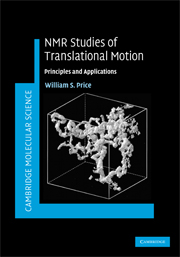Book contents
- Frontmatter
- Contents
- Preface
- Acknowledgements
- Abbreviations
- 1 Diffusion and its measurement
- 2 Theory of NMR diffusion and flow measurements
- 3 PGSE measurements in simple porous systems
- 4 PGSE measurements in complex and exchanging systems
- 5 PGSE hardware
- 6 Setup and analysis of PGSE experiments
- 7 PGSE hardware and sample problems
- 8 Specialised PGSE and related techniques
- 9 NMR imaging studies of translational motion
- 10 B1 gradient methods
- 11 Applications
- Appendix
- Index
- References
3 - PGSE measurements in simple porous systems
Published online by Cambridge University Press: 06 August 2010
- Frontmatter
- Contents
- Preface
- Acknowledgements
- Abbreviations
- 1 Diffusion and its measurement
- 2 Theory of NMR diffusion and flow measurements
- 3 PGSE measurements in simple porous systems
- 4 PGSE measurements in complex and exchanging systems
- 5 PGSE hardware
- 6 Setup and analysis of PGSE experiments
- 7 PGSE hardware and sample problems
- 8 Specialised PGSE and related techniques
- 9 NMR imaging studies of translational motion
- 10 B1 gradient methods
- 11 Applications
- Appendix
- Index
- References
Summary
Introduction
In the previous chapter we considered the various methods for relating echo attenuation with diffusion in the case of free isotropic diffusion for a single diffusing species. It was observed that the echo signal attenuation was single exponential with respect to q2 and the correct value of the diffusion coefficient was determined irrespective of the measuring time (i.e., Δ). Due to the relatively long timescale of the diffusion measurement (i.e., Δ), gradient-based measurements are sensitive to the enclosing geometry (or pore) in which the diffusion occurs (i.e., restricted diffusion) and an appropriate model must be used to account for the effects of restricted diffusion when analysing the data. The effects of the restriction can be used to provide structural information for pores with characterisitc distances (a) in the range of 0.01–100 μm. Thus, gradient methods are especially suited to studying the physics of restricted diffusion and transport in porous materials.
Non-single-exponential decays can arise in a number of ways including multicomponent systems, anisotropic or restricted diffusion. These effects are the subject of the next two chapters (more complex models are studied in Chapter 4). The relevant analytical formulae for diffusion between planes and inside spheres are presented (diffusion in cylinders is presented in the following chapter). It is remarked that these are the commonly used models for benchmarking numerical approaches. We also mention that Grebenkov has recently presented a review of NMR studies of restricted Brownian motion.
- Type
- Chapter
- Information
- NMR Studies of Translational MotionPrinciples and Applications, pp. 120 - 146Publisher: Cambridge University PressPrint publication year: 2009

